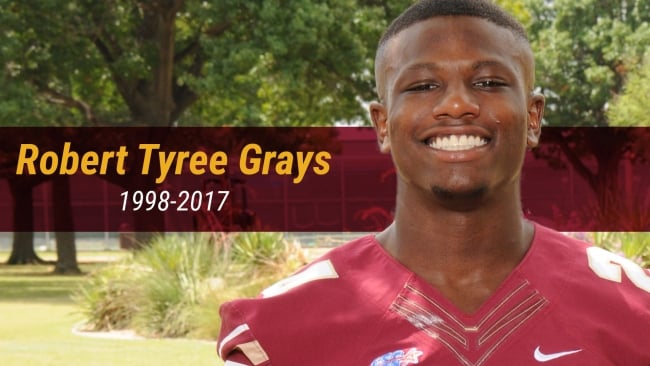You have /5 articles left.
Sign up for a free account or log in.

Midwestern State U
This has been one of the deadliest years for college football in decades.
Two players died after games last Saturday, CBS Sports and other news outlets reported, and three others died from football-related ailments during the off-season.
Robert Grays, who played for Midwestern State University, died after suffering a neck injury during a game Saturday, the university said. The 19-year-old Grays was a 5-foot-8-inch, 160-pound cornerback for NCAA Division II Midwestern State, which is located in Texas.
“Robert touched many lives while attending the university, but perhaps he will be remembered best for his smile,” Suzanne Shipley, the university’s president, said in a written statement. “He was an inspiration on and off the field to those around him, and he will be remembered with love and affection by his friends, classmates, coaches and teammates.”
Clayton Geib, a senior football player at the College of Wooster, died Sunday after complaining that he did not feel well after the Division III team's game Saturday, according to the college. Geib, who was 21, had cramps and was hyperventilating in the locker room after the game.
“Clayton was a wonderful student and member of the College of Wooster community, and beloved by many,” Wooster’s president, Sarah R. Bolton, said in a written statement. “Our hearts are breaking, and all our prayers and thoughts are with Clayton’s family, teammates and friends.”
Most of the 35 college football-related deaths since 2000 have been linked to overexertion rather than traumatic injury, CBS’s Dennis Dodd reported, citing research by Scott Anderson, the University of Oklahoma's head athletic trainer and an authority on player safety. However, traumatic brain injuries in football have been a focus in recent years.
“Training regimens are too often built on tradition versus based on science and place players at risk,” Anderson wrote in a 2012 research paper published by the Journal of Strength and Conditioning Research.
Earlier this year Dodd reported on several recent cases of Division I football players who were hospitalized after grueling workouts. In a particularly high-profile example from 2011, the University of Iowa concluded after an investigation that 13 Iowa football players were hospitalized after becoming ill with a muscle syndrome called rhabdomyolysis. The syndrome occurs when muscle is destroyed and releases into the bloodstream products that damage the kidneys. It can be caused by exercise and some dietary supplements.
Sickle-cell trait can also contribute to injury and death from overexertion.
A lawsuit filed by the family of a Rice University football player, Dale Lloyd, who died after a team workout in 2006 due to sickle cell-related complications, prompted the NCAA to recommend that teams test for the condition.
Yet college football player deaths related to overexertion and sickle cell, which affects one in 12 African-Americans, have continued.
Last year the University of California, Berkeley, settled a wrongful death lawsuit filed by the family of former Cal football player Ted Agu for $4.75 million. Agu, a pre-med student and defensive lineman, died at 21 shortly after a strenuous off-season conditioning workout, the San Francisco Chronicle reported.
Since 2000, six college football players have died from game-related traumatic injuries, according to Anderson. Tackling or blocking while leading with the head often is a cause. The NCAA has created rules aimed at reducing those injuries.
Yet Dodd, citing an unnamed witness to the play on which Grays was injured, said it was a routine tackle.
“If you really saw it, it was a football play,” the witness said. “He was in on a tackle. It was like anything you'd see on any other play.”
The last time two college football players died in the same year while playing the game (as opposed to during workouts) was in 2011, Dodd reported.
Also last Saturday, a Harvard University football player, Ben Abercrombie, severely injured his neck while making a tackle during the team’s loss to the University of Rhode Island.
Abercrombie, a first-year student, lost feeling in his arms and legs and has required breathing assistance since sustaining the cervical injury, ESPN reported. Doctors operated on his neck and are reportedly hopeful that the paralysis will subside.
Last month, The New York Times reported that Ed Cunningham, a college football analyst for the sports network ESPN, walked away from his job because of ethical concerns about injuries players sustain from the sport. Cunningham, who won an NCAA championship as a player at the University of Washington and who also played in the National Football League, in particular cited the risk of chronic traumatic encephalopathy, a degenerative brain disease found in many former football players.
“In its current state, there are some real dangers: broken limbs, wear and tear,” Cunningham told the newspaper. “But the real crux of this is that I just don’t think the game is safe for the brain. To me, it’s unacceptable.”




